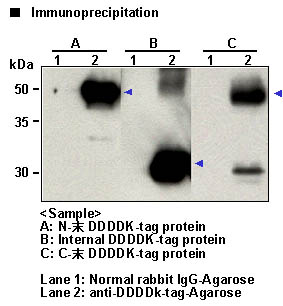Anti-DDDDK-tag pAb-Agarose
| Code | Size | Price |
|---|
| MBL-PM020-8 | Gel: 200 uL | £307.00 |
Quantity:
Prices exclude any Taxes / VAT
Overview
Host Type: Rabbit
Antibody Isotype: IgG
Antibody Clonality: Polyclonal
Regulatory Status: RUO
Application: Immunoprecipitation (IP)
Shipping:
4°C
Storage:
4°C
Images
Documents
Further Information
Applications:
IP - 20 uL
Background:
Epitope tagging is a powerful and
versatile strategy for detecting and purifying proteins
expressed by cloned genes. Short sequences encoding the
epitope tag are cloned in-frame with target DNA to
produce fusion proteins containing the epitope tag peptide.
Due to their small size, epitope tags do not affect the
tagged protein?s biochemical properties. Anti-epitope tag
antibodies can serve as universal purification or detection
reagents for any tag-containing protein. The DDDDK
epitope tag peptide sequence (DYKDDDDK) was first
derived from the 11-amino-acid leader peptide of the
gene-10 product from bacteriophage T7. The DDDDK
peptide has been widely used as a multi-purpose tag, and
anti-DDDDK antibody is optimally suited for identifying,
detecting, purifying, and monitoring the expression levels
of recombinant DDDDK fusion proteins.
Conjugate:
Agarose
Formulation:
320 ug of anti-DDDDK-tagpolyclonal antibody covalently coupled to 200 ul ofagarose gel and provided as a 50% gel slurry suspended inPBS containing preservative (0.09% sodium azide) for atotal volume of 400 ul.
Immunogen Translated:
Synthetic peptide binding KLH, DYKDDDDK
Reactivity:
This antibody recognizes DDDDK-tag
peptide sequence (DYKDDDDK) on Immunoprecipitation.
Shelf Life:
1 year
Source:
This antibody was purified from rabbit serum
using affinity column. The rabbit was immunized with
KLH conjugated DYKDDDDK peptide
Target:
DDDDK
References
1) Tan, L. J., et al., Genes Cells 17, 173-185 (2012)
2) Fukunaka, A., et al., J. Biol. Chem. 286, 16363-16373 (2011)
3) Takahashi , S., et al., J. Cell Sci. 122, 985-994 (2009)
4) Maehara, T., et al., J. Biol. Chem. 283, 35053-35059 (2008)
This antibody is used in these references.



